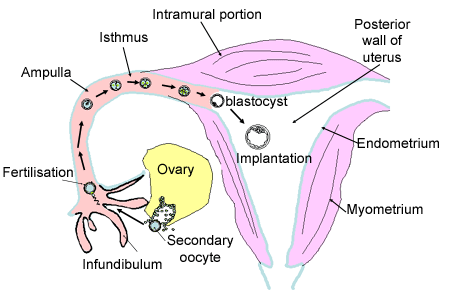Oviduct

The oviduct is also known as the fallopian or uterine tube. It
is the passageway through which the ovum passes from the ovary to
the uterine cavity.
The oviducts are part of the genital tract.
They have a wall of smooth muscle, an inner mucosal lining and
an outer layer of loose supporting tissue (serosa).
The lumen has a 'labyrinthine' appearance, as you can see in the
cross-section through the fallopian tube, shown below.
The proximal part is called the infundibulum,
which is flared and 'fringed' (fimbriated).
This leads into a longer, thin walled ampulla,
which has primary, secondary and tertiary longitudinal mucosal folds.
This leads into a short thicker-walled isthmus,
which has fewer longitudinal mucosal folds.
This leads into an intramural portion, that extends
through the uterine wall, and opens into the uterine lumen.
Take a look at this low power image of the fallopian tube.
Can you identify the serosa (adventitia layer),
muscularis mucosa layer, the mucosa,
which is very highly folded longitudinally, and the lumen.
The folded mucosa are where the ova are fertilised.
The fallopian tube is connected to the body wall by the broad ligament,
which also contains the blood supply to the serosa. You should be
able to identify some blood vessels in the serosa.
The muscle layer (muscularis mucosa) consists
of an outer longitudinal layer and inner circular layer.
Now take a look at this high power image of the mucosa. Can
you identify the richly vascularised lamina propria,
the basement membrane and the epithelial
cells.
There are three types of epithelial cell:
Peg cells - which are not ciliated (P). These
cells are secretory and have an extensive golgi, which lies above
the nucleus, towards the apical surface of the cell. These cells
secrete nutrient material for the ovum. The peg cells are particularly
prominent at day 14 of the menstrual cycle - ie. around the time
of ovulation.
Ciliated cells - The apical surface is ciliated,
and some cells have large accumulations of glycogen, which is stained
dark red in this PAS stained image. The cilia help to move the fluid
away from the ovary towards the uterus, thus moving the ovum towards
the uterus.
Intercalated cells - may be a morphological variant
of secretory cells.
